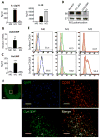Macrophage inflammatory markers are associated with subclinical carotid artery disease in women with human immunodeficiency virus or hepatitis C virus infection
- PMID: 24651679
- PMCID: PMC4067091
- DOI: 10.1161/ATVBAHA.113.303153
Macrophage inflammatory markers are associated with subclinical carotid artery disease in women with human immunodeficiency virus or hepatitis C virus infection
Abstract
Objective: Infection with hepatitis C virus (HCV) or human immunodeficiency virus (HIV) may be associated with atherosclerosis and vascular disease. Macrophages are a major component of atherosclerotic plaque, and classically activated (M1) macrophages contribute to plaque instability. Our goal was to identify plasma biomarkers that reflect macrophage inflammation and are associated with subclinical atherosclerosis.
Approach and results: We tested whether M1 macrophages produce galectin-3-binding protein in vitro. Then, we measured galectin-3-binding protein and the soluble macrophage biomarkers soluble cluster of differentiation (CD) 163 and soluble CD14 in 264 participants in the Women's Interagency HIV Study. Women were positive for HIV, HCV, both, or neither (66 in each group, matched for age, race/ethnicity, and smoking status). Carotid artery disease was assessed by ultrasound measurement of right distal common carotid artery intima-media thickness, distensibility, and presence of atherosclerotic lesions (intima-media thickness >1.5 mm). Plasma galectin-3-binding protein was higher in HCV+ than HCV- women (P<0.01) but did not differ by HIV status. The 3 inflammatory macrophage markers were significantly correlated with each other and negatively correlated with CD4+ counts in HIV-infected women. We defined a macrophage score as 1, 2, or 3 biomarkers elevated above the median. In models adjusted for traditional risk factors, higher macrophage scores were significantly associated with increased atherosclerotic lesions and lower carotid distensibility. Receiver-operator curve analysis of lesions revealed that the markers added predictive value beyond traditional risk factors and C-reactive protein.
Conclusions: The macrophage inflammatory markers galectin-3-binding protein, soluble CD163, and soluble CD14 are significantly associated with carotid artery disease in the setting of HIV and HCV infection.
Keywords: acquired immunodeficiency syndrome; atherosclerosis; immune system; risk factors; women.
Conflict of interest statement
Figures


Similar articles
-
Subclinical cardiovascular disease in HIV controller and long-term nonprogressor populations.HIV Med. 2020 Apr;21(4):217-227. doi: 10.1111/hiv.12820. Epub 2019 Nov 14. HIV Med. 2020. PMID: 31729142 Free PMC article.
-
Association of Macrophage Inflammation Biomarkers With Progression of Subclinical Carotid Artery Atherosclerosis in HIV-Infected Women and Men.J Infect Dis. 2017 May 1;215(9):1352-1361. doi: 10.1093/infdis/jix082. J Infect Dis. 2017. PMID: 28199691 Free PMC article.
-
Lipoprotein(a) and HIV: Allele-Specific Apolipoprotein(a) Levels Predict Carotid Intima-Media Thickness in HIV-Infected Young Women in the Women's Interagency HIV Study.Arterioscler Thromb Vasc Biol. 2017 May;37(5):997-1004. doi: 10.1161/ATVBAHA.117.309137. Epub 2017 Mar 23. Arterioscler Thromb Vasc Biol. 2017. PMID: 28336560 Free PMC article.
-
The Inflammatory Relationship Between Hepatitis C Virus With Coronary and Carotid Atherosclerosis.Cardiol Rev. 2021 Jul-Aug 01;29(4):178-183. doi: 10.1097/CRD.0000000000000314. Cardiol Rev. 2021. PMID: 32618587 Review.
-
Cardiovascular Implications of Immune Disorders in Women.Circ Res. 2022 Feb 18;130(4):593-610. doi: 10.1161/CIRCRESAHA.121.319877. Epub 2022 Feb 17. Circ Res. 2022. PMID: 35175848 Free PMC article. Review.
Cited by
-
Inflammation in HIV and Its Impact on Atherosclerotic Cardiovascular Disease.Circ Res. 2024 May 24;134(11):1515-1545. doi: 10.1161/CIRCRESAHA.124.323891. Epub 2024 May 23. Circ Res. 2024. PMID: 38781301 Free PMC article. Review.
-
HIV-1-Associated Atherosclerosis: Unraveling the Missing Link.J Am Coll Cardiol. 2017 Jun 27;69(25):3084-3098. doi: 10.1016/j.jacc.2017.05.012. J Am Coll Cardiol. 2017. PMID: 28641798 Free PMC article. Review.
-
Chronic hepatitis C virus infection: a new modifiable cardio-metabolic risk factor?Clujul Med. 2017;90(3):251-255. doi: 10.15386/cjmed-793. Epub 2017 Jul 15. Clujul Med. 2017. PMID: 28781519 Free PMC article. Review.
-
Female sex, high soluble CD163, and low HDL-cholesterol were associated with high galectin-3 binding protein in type 1 diabetes.Biol Sex Differ. 2019 Nov 21;10(1):51. doi: 10.1186/s13293-019-0268-0. Biol Sex Differ. 2019. PMID: 31752995 Free PMC article.
-
The Cholinergic Anti-Inflammatory Response and the Role of Macrophages in HIV-Induced Inflammation.Int J Mol Sci. 2018 May 16;19(5):1473. doi: 10.3390/ijms19051473. Int J Mol Sci. 2018. PMID: 29772664 Free PMC article. Review.
References
-
- Libby P, Ridker PM. Inflammation and atherosclerosis: role of C-reactive protein in risk assessment. Am J Med. 2004;116(Suppl 6A):9S–16S. - PubMed
-
- Stoger JL, Gijbels MJ, van der Velden S, Manca M, van der Loos CM, Biessen EA, Daemen MJ, Lutgens E, de Winther MP. Distribution of macrophage polarization markers in human atherosclerosis. Atherosclerosis. 2012;225:461–468. - PubMed
Publication types
MeSH terms
Substances
Grants and funding
- R01-HL-095140/HL/NHLBI NIH HHS/United States
- U01 AI103397/AI/NIAID NIH HHS/United States
- U01 AI031834/AI/NIAID NIH HHS/United States
- R01 HL095140/HL/NHLBI NIH HHS/United States
- U01-AI-034993/AI/NIAID NIH HHS/United States
- U01 AI034989/AI/NIAID NIH HHS/United States
- U01-AI-103401/AI/NIAID NIH HHS/United States
- UL1 TR000454/TR/NCATS NIH HHS/United States
- U01-AI-103397/AI/NIAID NIH HHS/United States
- U01 AI103401/AI/NIAID NIH HHS/United States
- UL1 TR000004/TR/NCATS NIH HHS/United States
- U01 AI103408/AI/NIAID NIH HHS/United States
- U01-AI-103390/AI/NIAID NIH HHS/United States
- U01-AI-034994/AI/NIAID NIH HHS/United States
- U01-AI-103408/AI/NIAID NIH HHS/United States
- U01 AI035004/AI/NIAID NIH HHS/United States
- R01 MH083579/MH/NIMH NIH HHS/United States
- R01-HL-083760/HL/NHLBI NIH HHS/United States
- P30 DK026743/DK/NIDDK NIH HHS/United States
- R01 HL083760/HL/NHLBI NIH HHS/United States
- U01-AI-035004/AI/NIAID NIH HHS/United States
- U01 AI034994/AI/NIAID NIH HHS/United States
- R01 HL115232/HL/NHLBI NIH HHS/United States
- U01-AI-034989/AI/NIAID NIH HHS/United States
- U01-AI-042590/AI/NIAID NIH HHS/United States
- U01-HD-032632/HD/NICHD NIH HHS/United States
- U01 AI103390/AI/NIAID NIH HHS/United States
- U01 AI034993/AI/NIAID NIH HHS/United States
- U01-AI-031834/AI/NIAID NIH HHS/United States
- U01 HD032632/HD/NICHD NIH HHS/United States
- U01 AI042590/AI/NIAID NIH HHS/United States
LinkOut - more resources
Full Text Sources
Other Literature Sources
Medical
Research Materials
Miscellaneous

